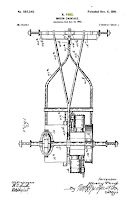James Bessen, Jennifer Ford, and Michael J. Meurer of Boston University School of Law published a paper titled, “The Private and Social Costs of Patent Trolls” on the topic of patent trolls in November 2011. The authors state, “NPE lawsuits are associated with half a trillion dollars of lost wealth to defendants from 1990 through 2010. During the last four years the lost wealth has averaged over $80 billion per year."
This piece of information has made its way around the Internet landing at many serious business publications like the Wall Street Journal and lots of influential tech blogs including many that have just recently learned how to spell patent.
"The Private and Social Costs of Patent Trolls" is a good paper with lots of compelling discussion on the negative impact of patent litigation brought by non-practicing entities. The financial arguments are sound, the numbers are good and supportable. Mr. Bessen presented his paper at the USPTO Patent Statistics conference in November, and he makes a very compelling case about the economic and social impact of NPE lawsuits and their impact on the organizations defending themselves against them. (I refuse to use the victim term here. You'll see why below.)
There is another important fact buried in the paper. It states:
"The mean NPE law suit occurs eight years after the patent is granted."
Consider what this means.
The average patent's pendency runs around 36 months. (It was slightly lower in the timeframe of the author's study but let's use 36 months for illustrative purposes.) There are plenty of patents in NPE litigation that were based on provisional applications so add another 12 months. Twelve years works either way - with or without a provisional when you consider how prior art is looked at. We are up to around four years of application pendency before the patent is granted. Now add eight years before one of the evil trolls takes action. So we now have a patent based on 12 year old science and technology. So, when an NPE litigates, the inventions are 12 years old. More than half way through their patent term.
NPEs are litigating patents with 12 year old technology.
The patent has been in the public domain for eight years before the NPE files suit. Eight years. Eight years that it's been on every free patent searching tool, eight years it's been in the tools for the patent cognoscenti, eight years that the patent examiners have had it as a source of prior art and as a consideration on the novelty of new patents that follow it.
NPEs enforce patents that has been in the public domain for eight years.
If the inventor decided to file a PCT, the patent application was published internationally, and if it was after 2001, domestically in the US. It may also have been translated into other languages - usually one of the trilateral languages - French, German, Japanese - but there are some in Korean and other languages. The patents litigated by NPEs have been out there in other languages.
More than one version of the eight year old patent has been in the public domain at the time the patent troll decided to litigate.
What do we learn from this?
Patent troll is really a pejorative term for guys who really know how to dig through the vast store of patent dreck to find valuable patents. (Investors in non-correlated assets take note.)
Patent trolls watch the market and find patents that are enforceable and that were largely ignored by their product producing business counterpart, the practicing entity because they have been making products covered by the patents. (Note to self, do freedom to operate search before finalizing the product.)
When the big voices of science and technology and their proxies start whining about how patent trolls are stifling innovation, what they are really saying is patent trolls do better research and have better tactics for finding valuable patents where the practicing entity has either decided not to get a license before building products or have decided to not to look at all.
How are patent trolls stifling innovation when they are dealing with 12 year old technology that has been public for around 8 years?
Please advise.








